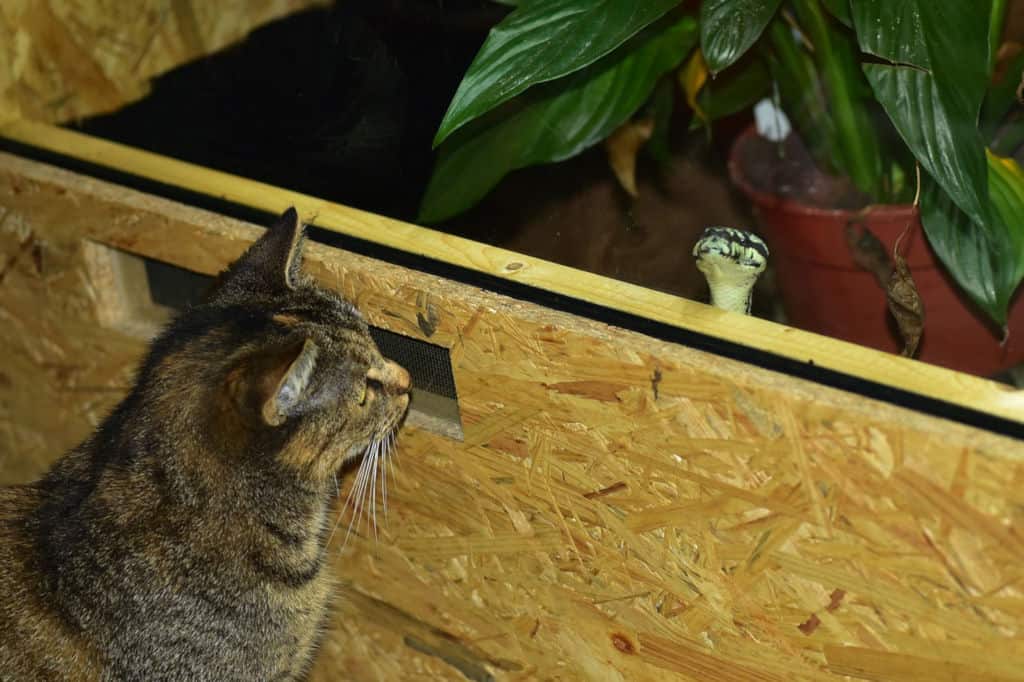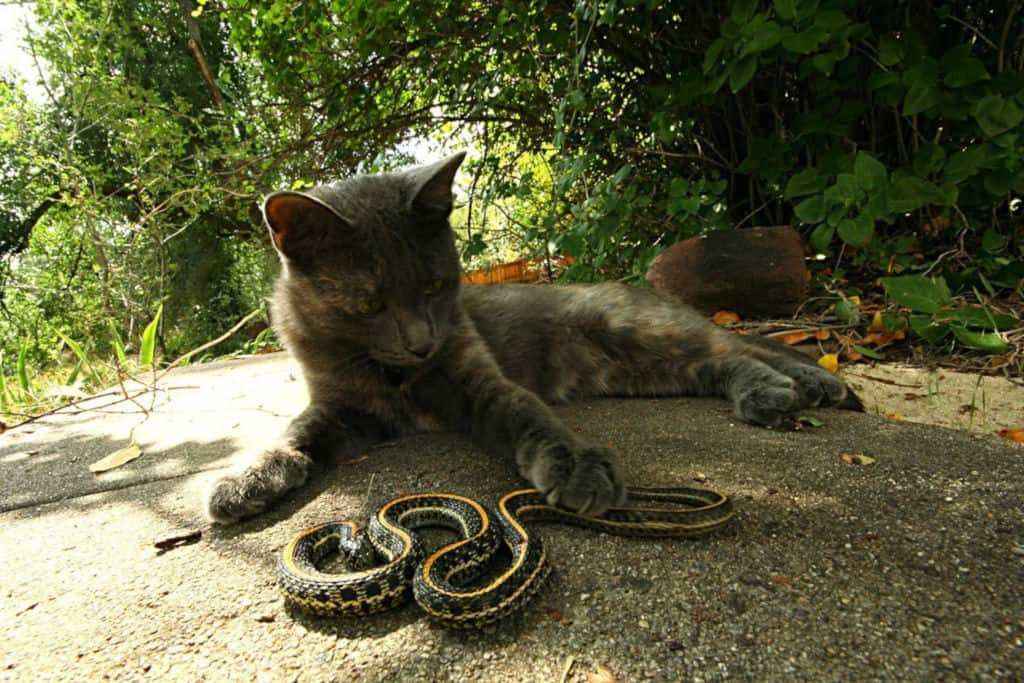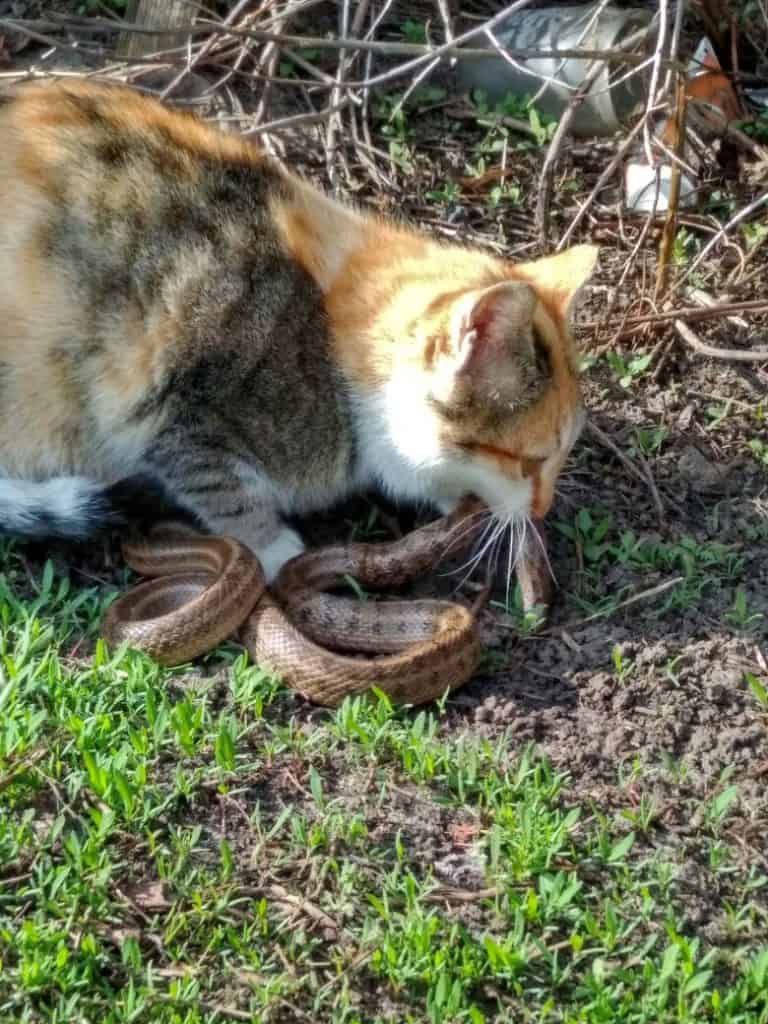Some people think that because cats hiss and have snake eyes, they are somehow related to snakes. Well, is there any truth to that?
The similar features between cats and snakes, like the hissing and eye shape, can be chalked up to convergent evolution, where unrelated species evolve similar traits due to having to adapt to similar environments or similar modes of life, not because of a shared lineage.
In this blog post, we explain why cats and snakes do similar things and the relationship between them.

Do Cats Have the Same Eyes As Snakes?
Because cats and snakes hunt in similar ways, their eyes evolved similarly. Vertical slit eyes help ambush because they have good depth perception and adapt well to low light. Which is what the majority of snakes and cats do.
Cats require careful control over the amount of light reaching their eyes since their eyes are so sensitive to light. When the cat’s pupils are reduced to slits rather than tiny circles, it has more control over how much light enters its eyes, which is especially crucial in intense sunlight.
To summarize, vertically slit eyes are typical in small ambush predators, such as cats. It helps them hunt and precisely determine how far they need to jump to catch their prey.
Interestingly, the mechanics of a cat’s eye adjusting to light is remarkably efficient, allowing them to detect motion in almost total darkness. This capability gives them an edge during dawn and dusk, their peak hunting times.
But just like species with vertical slit-shaped pupils are ambush predators, those with circular pupils are active foragers hunting down prey. Many foraging species have round eyes, including humans.
Round pupils are better suited to a diurnal creature, although they’re also not bad at night.
Why Do Cats Hiss Like Snakes?
When cats hiss, they mimic the sounds of their ancestors. It’s a defensive imitation instinct that arises when something defenseless is forced to behave in the manner of something not-so-defenseless. It’s a warning to another animal.
Hissing is an adaptation strategy employed by domestic and other small cats to fend off snakes and other predators by ‘speaking their language.’ Hissing is a universal warning signal among all creatures with the ability to hiss.
The universality of hissing across various species also underscores its effectiveness. For instance, a hiss is a sound even very young animals instinctively understand and react to, providing those who use it, like cats, an evolutionary advantage in the wild.

Cats may also hiss when stressed, threatened, or feeling displeasure. When a cat (or a kitten) feels fearful or insecure, it may hiss to show this irritation, usually as a warning sign.
Some claim the cat hisses to imitate a snake specifically. When you consider how a cat accomplishes it, it does make sense. It pulls its ears back, opens its jaws, and hisses loudly. By doing this, you can see how the cat sounds and looks more like a snake.
This may be enough to frighten another animal long enough for the cat to plot an attack or flee.
Many species benefit from “understanding” the communication patterns of other animals. You may argue that being able to interact efficiently with other animals is in their best interests. And hissing meets this description as a “universal” expression of discontent.
Are Cats Afraid of Snakes?
Snakes cause cats to be naturally cautious. However, most house cats aren’t typically afraid of snakes. If the snake is small and the cat is hungry, the cat will prey on it.
Typically, cats don’t have a natural fear of snakes. Your natural fluffy predator may stalk, hunt, and even kill a snake if given the opportunity.

A cat’s fear of a snake may vary depending on the snake’s size and whether the cat has previously interacted with a snake.
How Do Cats and Snakes Get Along With Each Other?
Cats and snakes aren’t particularly fond of one another. Snakes view cats as large predators who frequently hunt them for food. A house cat with previous interactions with a snake may actually hunt one if hungry enough.
While cats can kill snakes and, to some extent, keep them out of your yard, they will usually choose to avoid one other. House cats can easily catch snakes but may prefer easier-to-grab prey if the snake appears too big.
If you find your feline fixating on a snake in your yard or home, it’s advisable to intervene for both their safety. While cats are adept hunters, some snakes possess venom potent enough to cause severe reactions in pets.
Owners who have both cats and reptiles as pets should always ensure they are separated. The instinctual behaviors of both can lead to unintentional injuries, particularly if the snake feels cornered or if the cat is in hunting mode.
When it comes to evolution, all current amniotes (reptiles, birds, and mammals) have a lizard-like ancestor who lived over 300 million years ago.
That lizard-like amniote’s lineage eventually split into two, the Diapsids, which included reptiles and birds, and the Synapsids, which ultimately led to mammals. We all have a common ancestor somewhere down the line.
This shared ancestral journey, while leading cats and snakes down different evolutionary paths, shows the interconnectedness of life. Though our pets like cats have evolved much since then, understanding these roots can give us a unique insight into their behaviors and instincts today.
FAQs
Cats, like humans, are not related to reptiles. Cats, humans, and all other animals are descended from the same reptilian ancestor. However, none of our predecessors were technically reptiles, despite their appearance.
Are house cats immune to snake venom?
Cats have no defense against poisonous bites. It’s an old wives’ story that cats are immune. A bitten cat will get sick and possibly die if an effective antivenom isn’t administered within two hours of the bite. Interestingly, humans and cats are twice as likely to survive a snake bite compared to dogs.
Are snakes afraid of cats?
Snakes are typically wary of cats because they consider them larger predators. Since most snakes are slow compared to a cat’s speed and agility, a cat can easily capture and eat one. If the snake cannot flee, it will engage in defensive actions such as hissing, tail shaking, and striking.
Alex, a passionate animal lover, has experience in training and understanding animal behavior. As a proud pet parent to two dogs and three cats, he founded AnimalReport.net to share insights from animal experts and expand his knowledge of the animal kingdom.




